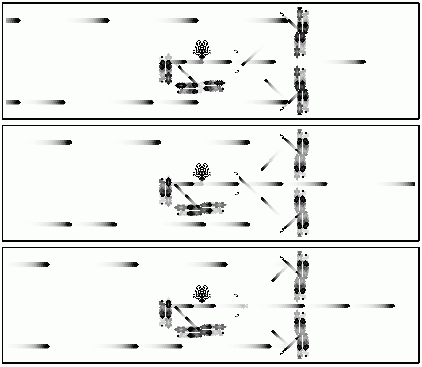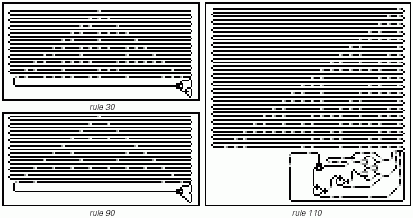| |
SOME HISTORICAL NOTES

From: Stephen Wolfram, A New Kind of Science
Notes for Chapter 11: The Notion of Computation
Section: Class 4 Behavior and Universality
Page 1117
[Universality in] 2D cellular automata. Universality was essentially built in explicitly to the underlying rules for the 2D cellular automaton constructed by John von Neumann in 1952 as a model for self-reproduction. For among the 29 possible states allowed for each cell were ones set up to behave quite directly like components for practical electronic computers like the EDVAC - as well as to grow new memory areas and so on. In the mid-1960s Edgar Codd showed that a system similar to von Neumann’s could be constructed with only 8 possible states for each cell. Then in 1970 Roger Banks managed to show that the 2-state 5-neighbor symmetric 2D rule 4005091440 was able to reproduce all the same logical elements. (This system, like rule 110, requires an infinite repetitive background in order to support universality.) Following the invention of the Game of Life, considerable work was done in the early 1970s to identify structures that could be used to make the analog of logic circuits. John Conway worked on an explicit proof of universality based on emulating register machines, but this was apparently never completed. Yet by the 1980s it had come to be generally believed that the Game of Life had in fact been proved universal. No particularly rigorous treatments of the system were given, and the mere existence of configurations that can act for example like logic gates was often assumed immediately to imply universality. From the discoveries I have made, I have no doubt at all that the Game of Life is in the end universal, and indeed I believe that the kind of elaborate behavior needed to support various components is in fact good evidence for this. But the fact remains that a complete and rigorous proof of universality has apparently still never been given for the Game of Life. Particularly in recent years elaborate constructions have been made of for example Turing machines. But so far they have always had only a fixed number of elements on their tape, which is not sufficient for universality. Extending constructions is often very tricky; much as in rule 110 it is easy for there to be subtle bugs associated with rare mismatches in the placement of structures and timing of interactions. The pictures below nevertheless show a rather simple implementation of a Nand gate in Life. The input comes from the left encoded as the presence or absence of spaceships 92 cells apart. The spaceships are converted to gliders. When only one glider is present, a new spaceship emerges on the right as the output. But when two gliders are present, their collision forms a wall, which prevents output of the spaceship.

If one considers rules with more than two colors, it becomes straightforward to emulate standard logic circuits. The pictures below show how 1D cellular automata can be implemented in the 4-color WireWorld cellular automaton of Brian Silverman from 1987, whose rules find the new value of a cell from its old value a and the number u of its 8 neighbors that are 1’s according to a/.{0->0, 1->2,2->3,3:>If[0<u<3,1,3]}

Stephen Wolfram, A New Kind of Science (Wolfram Media, 2002), page 1117.
© 2002, Stephen Wolfram, LLC
|
|